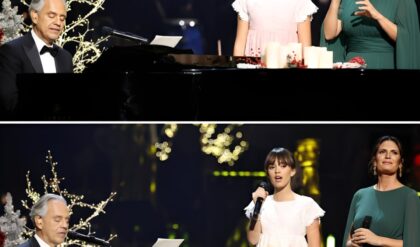My Oxford Year, Netflix’s latest romantic drama, has surged to the top of the streamer’s charts since its release on August 1, 2025, captivating audiences with a poignant blend of romance, tragedy, and literary charm. Directed by Iain Morris and adapted from Julia Whelan’s 2018 novel of the same name, the film stars Sofia Carson as Anna De La Vega, an ambitious American student, and Corey Mylchreest as Jamie Davenport, her charismatic British teaching assistant. Set against the dreamy spires of Oxford University, this 112-minute tale has been dubbed a “romcom” but defies expectations with a tear-soaked twist that echoes One Day and Normal People. Fans and critics alike have praised its emotional depth, calling it “worth every painful minute.” This article delves into the film’s narrative, performances, themes, and the devastating twist that has left viewers reeling, drawing on web sources and fan reactions.
A Literary Love Story with a Tragic Core
At its heart, My Oxford Year is a story about seizing the moment and finding meaning in fleeting connections. Anna De La Vega, a driven New Yorker born to Latinx immigrants, arrives at Oxford University to fulfill a childhood dream of studying Victorian poetry before embarking on a high-flying career at Goldman Sachs. Her meticulously planned life—college, Oxford, Wall Street—unravels when she meets Jamie Davenport, a charming, Eton-educated PhD student who steps in as her poetry professor’s teaching assistant. Their relationship begins with an enemies-to-lovers spark, marked by witty banter over Tennyson and Browning, but quickly deepens into a romance that challenges Anna’s priorities.
The film’s Oxford setting is a character in itself, with cinematographer Chris Baker capturing the city’s golden-hued colleges, cobblestone streets, and cozy pubs. Unlike the typical romcom’s lighthearted tone, My Oxford Year leans into a bittersweet narrative, blending poetry-soaked flirtations with weighty themes of love, loss, and personal growth. The screenplay, crafted by Allison Burnett, Melissa Osborne, and Whelan, diverges from the novel by streamlining the protagonist’s backstory—renaming Ella to Anna and swapping her political ambitions for a finance-driven path—but retains the emotional core of Whelan’s story. Producer Marty Bowen, who drew on his own short-lived Oxford romance, infuses the film with a sense of heightened urgency, emphasizing that even brief moments can shape a lifetime.
The narrative’s structure, split into two distinct halves, mirrors Anna’s transformation. The first half is a vibrant campus romance, complete with quirky friends, literary debates, and montage-fueled chemistry. Anna’s eclectic group—Charlie (Harry Trevaldwyn), Maggie (Esmé Kingdom), and Tom (Nikhil Parmar)—adds levity, their banter evoking a modern Bridget Jones. However, the second half shifts into heavier territory, revealing a truth about Jamie that upends Anna’s world and reframes the story as a meditation on mortality and choice. This tonal pivot, while jarring for some, has resonated with viewers, who describe it as a “life story” rather than a traditional romcom.
Performances That Anchor the Emotional Rollercoaster
Sofia Carson delivers a complex performance as Anna, balancing ambition with vulnerability. Critics have noted her growth as a Netflix leading lady, moving beyond the brashness of Purple Hearts to portray a character who evolves from a self-assured scholar to a woman grappling with love’s impermanence. While some reviews critique her early stiffness—described as a “smug smirk” or “Pick Me Girl” energy—Carson shines in the film’s emotional climax, where her restraint and depth convey Anna’s heartbreak. Corey Mylchreest, fresh from Queen Charlotte: A Bridgerton Story, steals the show as Jamie, blending charisma, vulnerability, and a Hugh Grant-esque charm. His ability to navigate both romantic levity and tragic weight makes him the film’s emotional anchor, with reviewers hailing him as a breakout star.
The supporting cast elevates the film’s texture. Dougray Scott, as Jamie’s father, delivers a standout performance, bringing gravitas to scenes that ground the story’s melodrama. Harry Trevaldwyn, Esmé Kingdom, and Nikhil Parmar inject humor and warmth as Anna’s friends, their quirky dynamic cutting through the film’s heavier moments. Additional roles by Poppy Gilbert, Catherine McCormack, Hugh Coles, and Barney Harris add depth, though some critics note the secondary characters lack fully fleshed-out arcs, serving primarily as foils for Anna and Jamie’s journey.
The chemistry between Carson and Mylchreest is a highlight, bolstered by their shared scenes of poetry analysis and late-night confessions. While some argue their romance feels rushed—relying on montages rather than deep character development—their palpable connection carries the story through its emotional peaks and valleys. The film’s authenticity is enhanced by Whelan’s own Oxford experience, which informs the vivid depiction of college life, from punting on the River Cherwell to debates in historic lecture halls.
A Tear-Soaked Twist That Redefines the Narrative
Spoiler Warning: This section contains plot details. The film’s defining moment is its midway reveal: Jamie has terminal cancer and chooses not to pursue treatment, a secret that shatters the romcom facade. This twist, unforeseen by viewers unfamiliar with Whelan’s novel, has sparked intense reactions online, with fans posting tearful TikToks and tweets like, “I thought #MyOxfordYear would be a romcom but it ended up destroying me.” The revelation reframes the story, shifting focus from Anna’s academic dreams to Jamie’s mortality, forcing both characters to confront what it means to love when time is finite.
The twist draws comparisons to The Fault in Our Stars and Me Before You, but My Oxford Year distinguishes itself by grounding the tragedy in Anna’s agency. Rather than wallowing in despair, she chooses to embrace the moment, staying in England to cherish her time with Jamie. This decision, while controversial—some critics argue it lacks narrative justification—resonates with the film’s core message: “It doesn’t matter how long something lasts, as long as it’s meaningful.” The ending, where Jamie succumbs to his illness, leaves Anna to carry forward his love of poetry and her redefined sense of purpose, delivering a bittersweet catharsis that has viewers reaching for tissues.
Additional surprises include the class dynamics between Anna, a scholarship student, and Jamie, a privileged lord’s son. A pub altercation hints at tensions around race and class, but the film’s treatment of these themes is fleeting, drawing criticism for its idealized view of Oxford. Another subtle twist involves Anna’s shift from a finance-driven future to embracing a life shaped by art and love, reflecting Whelan’s own journey from acting to writing. While some find the dialogue overly platitudinous—“The best parts of life are the messy bits!”—others see it as fitting the film’s literary tone.
Critical Reception and Cultural Resonance
Since its debut, My Oxford Year has polarized audiences, earning both fervent praise and measured critique. Fans on social media laud its emotional impact, with one viewer noting, “It taught me to love harder when time is short.” The film’s 3.0/5 rating on review aggregators reflects its divisive nature: supporters call it “devastatingly beautiful,” while detractors, like ScreenRant, argue it leans on “melodrama for melodrama’s sake” and romanticizes academia excessively. Collider’s review likens it to a “2010s YA adaptation,” citing its reliance on clichés and dated tropes, yet acknowledges its cozy appeal for romcom fans.
The film’s strength lies in its ability to evoke raw emotion, even if it sacrifices narrative depth for tear-jerking moments. Its Oxford setting and literary references appeal to Anglophiles and fans of Normal People, while its tragic arc aligns with One Day’s exploration of love’s impermanence. However, the marketing as a romcom has drawn ire, with viewers like one tweeting, “The most severe case of false advertising since Time Cut.” The runtime, at just under two hours, has been called bloated, with montages and poetic platitudes overshadowing character development.
Despite flaws, My Oxford Year succeeds as comfort viewing, offering a visually lush escape and a romance that resonates with those willing to embrace its emotional manipulation. Its themes of carpe diem and the interplay of love and grief strike a universal chord, amplified by Carson and Mylchreest’s chemistry and the evocative Oxford backdrop. The film’s cultural impact is evident in its rapid rise to Netflix’s #1 spot, fueled by viral fan reactions and word-of-mouth buzz.
Conclusion
My Oxford Year is a paradox—a romcom that breaks hearts, a love story that grapples with loss, and a coming-of-age tale wrapped in literary nostalgia. Sofia Carson and Corey Mylchreest deliver performances that anchor the film’s emotional highs, while the Oxford setting and supporting cast add charm and texture. The cancer twist, though divisive, transforms the narrative into a poignant reflection on living fully in the face of impermanence. While critics note its reliance on clichés and idealized academia, the film’s emotional resonance and visual allure make it a standout in Netflix’s romance catalog. For viewers seeking a tear-soaked journey that’s “worth every painful minute,” My Oxford Year delivers, leaving a lasting impression long after the credits roll.





